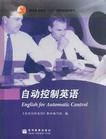自动控制英语
出版时间:2008-1 出版社:高等教育出版社 作者:自动控制英语教材编写组 编 页数:220
前言
专门用途英语系列教材是教育部规划的高等院校专业英语阶段的英语教材。本系列教材从高等技术应用型人才培养的总体目标出发,结合学生毕业后的工作实际,力求向学生提供其未来工作岗位所需要的专业英语知识技能,培养学生使用涉外业务英语的能力。 本系列教材主要供高等院校(包括高等专科院校和高等职业院校)专业英语教学使用,也可供电大、各类成人院校及广大专业人员学习专业英语、提高涉外业务交际能力使用。 《自动控制英语》系专门用途英语系列教材中的一种,旨在提高自动控制类专业的学生和自动控制行业从业人员在其行业中涉外业务英语的交际能力,包括专业阅读、翻译、写作和口头交际的能力。
内容概要
《自动控制专业英语》系专门用途英语系列教材中的一种,旨在提高自动控制类专业的学生和自动控制行业从业人员在其行业中的涉外业务英语交际能力,包括专业阅读、翻译、写作和口头交际的能力。教材选题新颖、内容丰富、语言规范。全书共10个单元,内容涉及自动控制技术的各个方面。每单元包括专业文献阅读、翻译技巧训练、实际应用文写作练习和口语对话练习。书后附有参考答案、参考译文和词汇表等。本书附有MP3并配有录音带。 专门用途英语系列教材是教育部规划的高等学校(包括高等专科院校和高等职业院校)专业英语阶段的英语教材,也可供电大、各类成人院校以及广大专业人员学习专业英语、提高涉外业务交际能力使用。
书籍目录
Unit1 Control SystemReading ComprehensionReading A: Control SystemReading B: Design, Modeling and Analysis of Control SystemTranslation Skills: 词义的选择Practical Writing: 广告Communicative SpeakingUnit2 The Future of Control SystemReading ComprehensionReading A: Controlling the FutureReading B: Key Control Technology for the FutureTranslation Skills: 词义的引伸Practical Writing: 求职信Communicative SpeakingUnit3 Competition Between PLC and PCReading ComprehensionReading A: Its All a Question of Control (1)Reading B: Its All a Question of Control (2)Translation Skills: 转换翻译法Practical Writing: 履历表Communicative SpeakingReading ComprehensionUnit4 Automated Network ControlReading A: Automated Network Control and Supervision (1)Reading B: Automated Network Control and Supervision (2)Translation Skills: 增词译法Practical Writing: 感谢信Communicative SpeakingUnit5 The Revolution of Control SystemReading ComprehensionReading A: The Silent Revolution (1)Reading B: The Silent Revolution (2)Translation Skills: 省词译法Practical Writing: 邀请信Communicative SpeakingUnit6 Control TechnologyReading ComprehensionReading A: Automated Control of Mobile NetworksReading B: New Control Center TechnologyTranslation Skills: 改变词序译法Practical Writing: 询价信Communicative SpeakingUnit7 Automatic Control System and Control NetworkReading ComprehensionReading A: Automatic Control System and Control NetworkReading B: Automated Control of the Raytheon Personal Rapid Transmit SystemTranslation Skills: 否定句的译法Practical Writing: 报价信Communicative SpeakingUnit8 Energy Management System Conrtol CentersReading ComprehensionReading A: EMS Control Centers, Then and NowReading B: Challenges and Goals of Numerical AwarenessTranslation Skills: 被动语态的译法Practical Writing: 订货Communicative SpeakingUnit9 A Ride Control SystemReading ComprehensionReading A: A Ride Control SystemReading B: Cross Directional ControlTranslation Skills: 定语从句的译法Practical Writing: 索赔函Communicative SpeakingUnit10 Advantages of Using Control SystemReading ComprehensionReading A: Centralized Automated Control Saves US$1.5M for New Zealands Largest Energy ProviderReading B: MED 03 Conference ReportTranslation Skills:状语从句的译法Practical Writing:企业简介Communicative Speaking参考答案参考译文VocabularyPhrases
章节摘录
The desire to control the forces of nature has been with man since early civilizations. Although many examples of control systems existed in early times, it was not until the mid-eighteenth century that several steam-operated control devices appeared1. This was the time of the steam engine, and perhaps the most noteworthy invention was the speed-control fly ball governor invented by James Watt. Around the beginning of the twentieth century much of the work in control systems was being done in the power generation and the chemical processing industry. Also by this time, concept of the autopilot for airplanes had been fairly well developed. The period beginning about twenty-five years before World War Two saw rapid advances in electronics and especially in circuit theory, aided by the now classical work of Nyquist in the area of stability theory2. The requirements of sophisticated weapon systems, submarines, aircrafts and the like gave new impetus to the work in control systems before and after the war.
图书封面
评论、评分、阅读与下载
